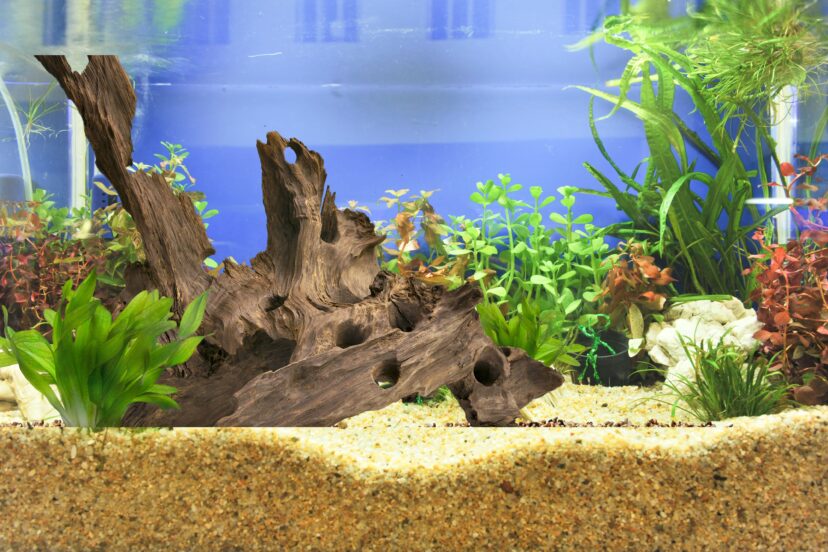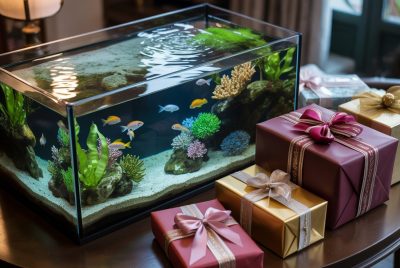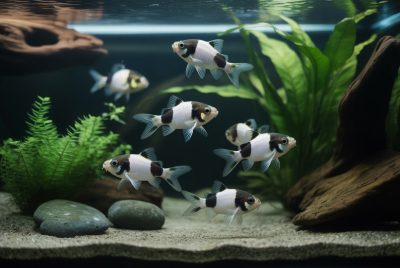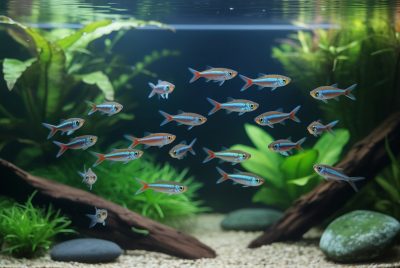Driftwood Aquascape
*We may earn a commission for purchases made using our links. Please see our disclosure to learn more.
Standing before my flourishing underwater masterpiece, I find myself entranced by the symphony of life I’ve cultivated. The gentle sway of aquatic plants, the shimmering dance of colorful fish, and at the center of it all, the captivating driftwood.
In this article, I invite you to accompany me on my odyssey of designing a mesmerizing driftwood aquascape. From the painstaking selection of the perfect driftwood pieces to the assembly of a thriving ecosystem, every step was a revelation. Along the way, I’ll also share invaluable recommendations for products that have been instrumental in turning my vision into a reality.
The Driftwood Aquascape Vision
Before embarking on the practicalities of selecting driftwood, it’s vital to take a moment to envision the world you’re about to create. I wanted my aquascape to evoke the tranquility of a woodland stream, with driftwood forming the sturdy, weathered bones of the scene. This vision served as a guiding light, influencing the choice of flora and fauna that would inhabit this underwater realm.
With this inspiration in mind, I delved into the process of selecting driftwood that would not only fit this vision but breathe life into it.
Selecting the Right Driftwood
- Lorem ipsum dolor sit amet, consectetur adipiscing elit.
- Cras ultricies nisi quis augue elementum elementum.
- Nam commodo orci sed metus commodo, ut placerat sapien congue.
- Donec id quam fringilla, blandit eros a, ornare nisl.
- Aenean interdum odio ut neque vestibulum, quis sollicitudin felis mattis.
- Lorem ipsum dolor sit amet, consectetur adipiscing elit.
- Cras ultricies nisi quis augue elementum elementum.
- Nam commodo orci sed metus commodo, ut placerat sapien congue.
- Donec id quam fringilla, blandit eros a, ornare nisl.
- Aenean interdum odio ut neque vestibulum, quis sollicitudin felis mattis.
Malaysian Driftwood
The cornerstone of any captivating aquascape lies in the careful selection of driftwood. It is more than just an ornamental addition; it is the very foundation upon which the entire underwater world will thrive. The journey to find the perfect pieces was a voyage of discovery that took me through countless online stores and local aquarium shops, seeking that elusive combination of intriguing form and texture.
As I scoured through the offerings, it was clear that each piece had its own unique tale to tell. The Malaysian driftwood, with its gnarled and twisted branches, appeared to bear the scars of ancient battles waged against the elements. Every twist and turn spoke of a history entwined with the forces of nature. A testament to the resilience of life itself.
WDEFUN offers a 7-pack of natural large aquarium spiderwood, crafted from wood slats, each ranging from 4 to 8 inches in size. Made from natural wood, these pieces aid in replicating natural aquatic environments, providing a diverse range of shapes and sizes to add natural beauty to fish tanks. Beyond aquarium decoration, they're suitable for home, garden, terrace, and desktop decor.
- Natural Material: Crafted from natural wood slats, aiding in the simulation of natural aquatic environments.
- Variety of Sizes: Each pack offers diverse shapes and sizes (4" to 8"), adding natural beauty to aquariums.
- Multi-Purpose Use: Suitable not only for fish tanks but also for home, garden, terrace, and desktop decoration.
Spiderwood
On the other hand, the Spiderwood unveiled a different kind of beauty. Its delicate, branching structure seemed to extend like the legs of an arachnid, gently reaching into the depths of the aquatic world. There was an eerie elegance to it, a reminder that even in the watery depths. Nature could create something that was both delicate and hauntingly beautiful.
Each piece held a unique energy, a story of its own, waiting to be woven into the tapestry of the aquascape. It was not just about selecting driftwood. It was about choosing partners in this creative endeavor, each one with its own character and contribution to make. With these carefully chosen driftwood pieces, I was poised to embark on the next step of this aquascaping journey.
Preparing the Driftwood
Seachem Purigen Organic Filtration Resin is a revolutionary filtration medium designed to maintain optimal water quality in aquariums. Unlike typical ion exchangers or adsorbents, this unique macro-porous synthetic polymer efficiently eliminates both soluble and insoluble impurities from the water. Its selectivity targets nitrogenous compounds and waste, ensuring crystal-clear water for aquatic environments.
- Effective Filtration: Purigen efficiently removes impurities, ensuring crystal-clear water by targeting waste and nitrogenous compounds.
- High Capacity: Its unique structure increases surface area, boosting its ability to trap impurities compared to standard resins.
- Regeneration Option: It can be regenerated with a bleach solution, extending its usability and saving costs.
- Product Sensitivity: Certain slime coat products can interfere with its effectiveness.
- Odor Detection Needed: Detecting bleach or chlorine odors can complicate the regeneration process.
- Complex Regeneration: The bleach and water regeneration process requires careful handling and attention to ensure safe and effective reuse.
Seachem Purigen
Before granting my driftwood a place in this underwater haven, it was imperative to ensure it was safe and ready for its subaqueous existence. This pivotal stage demanded both patience and precision. With deliberate care, I immersed the pieces in a large container. Allowing them to become fully acquainted with their newfound aquatic environment. It was a ritualistic dance that spanned several weeks, a testament to the gravity of this crucial step.
This prolonged immersion served a dual purpose. Firstly, it acted as a thorough cleansing process, purging the driftwood of any lingering impurities. The water was changed at regular intervals, like a steady heartbeat, ensuring that no remnants of tannins or other substances would jeopardize the clarity and vitality of the aquarium’s ecosystem. This meticulous regimen not only prevented potential water discoloration but also laid the foundation for a thriving aquatic environment.
Secondly, this extended soak was instrumental in addressing any buoyancy issues that might have arisen. By allowing the driftwood to absorb water gradually, it became properly waterlogged. Ensuring that once placed in the aquarium, it would gracefully sink to the desired position. This step was pivotal in achieving the natural and balanced aesthetic that I envisioned for my aquascape.
The process was akin to an initiation, a passage through which the driftwood underwent a transformation. Shedding its terrestrial identity to embrace its new role as an essential element of this underwater haven. It was a testament to the dedication required to create a harmonious and thriving aquatic ecosystem, where every detail was meticulously considered for the well-being of its inhabitants.
Designing the Layout
Capetsma presents a 5-in-1 aquascaping toolset crafted from forged stainless steel, including straight and curved tweezers, aquatic curved scissors, a substrate spatula, and 100 pH testing strips. This modern set comes in a velvet pouch for convenient storage. Designed to prevent interference and injuries to aquatic plants, it facilitates precise maintenance without disturbing aquarium decor or contaminating water.
- Versatile Set: Includes tools for precise aquarium plant maintenance.
- Quality Build: Forged stainless steel ensures durability and flexibility.
- Safety Features: Anti-slip clip ends prevent plant damage and debris in the aquarium.
- Possible Missing Parts: Instances of missing components reported.
- Limited Warranty Details: Warranty coverage specifics not specified.
- pH Tester Information: Accuracy or reliability of pH testing strips not detailed.
Capetsma Aquascape Tools
With my prepared driftwood at hand, it was time to give shape to my vision. This was the moment where artistry met nature, and each piece of driftwood became a brushstroke on the canvas of my underwater world.
I chose to embrace a dynamic, asymmetrical design, mirroring the untamed rhythm of nature itself. The deliberate placement of each piece was a dance of balance and composition. The larger, more imposing sections found their home towards the back, forming a sturdy backbone to the aquascape. These pieces were like ancient sentinels, their gnarled forms evoking a sense of wisdom and strength.
In contrast, the smaller branches sprawled forward, reaching out like eager tendrils. They added a sense of movement and fluidity to the composition, creating layers of depth and intrigue. It was as if I was sculpting with life itself, orchestrating a symphony of forms that would enthrall any observer.
As I arranged the driftwood, I was acutely aware of how each piece interacted with its surroundings. The negative spaces between branches became sheltered alcoves for fish to explore. While the gaps allowed water to flow freely, mimicking the natural currents of a riverbed. It was a meticulous process, akin to arranging a puzzle where every piece had its place and purpose.
In the end, the aquascape felt like a living tapestry, a testament to the intricate dance of existence that unfolds beneath the waves. Every branch and leaf, carefully chosen and positioned, contributed to this harmonious tableau. It was a reflection of the delicate balance that nature achieves effortlessly, and a tribute to the artistry of aquascaping.
Choosing Complementary Flora and Fauna
Anubias Barteri Var. Nana
The Planterest Anubias Barteri Var. Nana is a live aquarium plant that brings natural beauty to aquatic environments. This potted plant, measuring between 2 to 5 inches in length, showcases the Anubias Barteri Var. Nana, a popular and visually striking aquatic species. Planterest ensures quality and offers a guarantee of 7 days for plant survival, supported by 30 years of experience in delivering top-notch products.
- Vibrant Aquatic Addition: Enhances aquarium aesthetics with vibrant greenery.
- Hardiness and Adaptability: Thrives in various lighting conditions, suitable for all experience levels.
- Quality Assurance: 7-day survival guarantee demonstrates commitment to product quality.
- Variable Sizing: Size may vary (2-5 inches), leading to differing expectations.
- Watering Needs: Moderate watering label might be subjective, challenging for beginners.
- Weather Considerations: Optional ice or heat pack for extreme weather could complicate shipping.
Java Fern
The Java Fern by Mainam is a microsorum plant known for its versatility and ease of growth in aquariums. It thrives in low-light conditions and provides an excellent natural aesthetic to aquatic environments. This live aquarium plant is carefully cultivated, planted on driftwood, and ensures an optimal and healthy habitat for fish while adding a touch of natural beauty to any aquatic setting.
- Low Maintenance: Requires minimal care, making it perfect for those new to aquarium plants or those seeking easy-to-manage greenery.
- Natural Habitat Mimicry: Offers fish hiding spots and resembles their natural environment, enhancing the aesthetics and comfort of the aquarium.
- Quality Assurance: Backed by a 3-day guarantee from Mainam, ensuring the plant arrives healthy and ready to thrive in your aquarium.
- Slow Growth: Doesn't grow rapidly, so it might take time to achieve the desired look or coverage in the tank.
- Attachment Effort: Initial securing of the fern to driftwood or rocks might require some patience and additional materials until it establishes itself.
- Water Sensitivity: While resilient, sudden fluctuations in water conditions can impact its health, necessitating a stable and consistent environment for optimal growth.
To complement the striking driftwood, I meticulously curated a selection of aquatic plants and fish. This step was crucial in adding the final touches to my underwater masterpiece, creating a harmonious blend of flora and fauna.
Among the plants, I opted for species known for their adaptability and low-light requirements. The Anubias and Java Ferns were the chosen champions, their hardy nature making them perfect candidates for finding their place in the nooks and crannies of the driftwood. As their roots intertwined with the driftwood’s gnarled forms, they seemed to find sanctuary in their new abode.
These plants brought a burst of vibrant green to the aquascape, a striking visual contrast to the natural tones of the wood. It was a juxtaposition of life and antiquity, where the fresh, verdant hues breathed vitality into the weathered, stoic driftwood. It was a testament to the resilience of nature, as these plants thrived in their newfound home, their leaves dancing in the currents created by the aquarium’s inhabitants.
The plants not only served an aesthetic purpose but also contributed to the overall health of the ecosystem. Their presence aided in oxygenation and provided shelter for smaller aquatic creatures. Creating a dynamic and thriving environment.
In the end, the union of driftwood and plants was a testament to the artistry of aquascaping. It was a deliberate fusion of natural elements, each piece contributing its unique beauty to the whole. Together, they transformed the aquarium into a living tableau, a captivating glimpse into the intricate dance of life beneath the waves.
Neon Tetras
The Green Neon Tetra, part of Neat&Tidy's aquatic range, is a vibrant and visually striking freshwater fish from South America, closely related to the popular Neon Tetra. Its vivid green and neon blue hues make it a captivating addition to any well-maintained aquarium. With its peaceful temperament and preference for shoaling, these tetras thrive in groups and offer a visually stunning display when kept in optimal conditions.
- Vibrant Coloration: Stunning green and neon blue hues enhance aquarium aesthetics.
- Easy Maintenance: Thrives in accessible soft, slightly acidic water conditions and peaceful shoaling.
- Adaptable Diet and Breeding: Accepts varied foods; breeding in separate tanks offers enthusiasts a rewarding experience.
- Water Parameter Sensitivity: Requires precise pH and temperature conditions, demanding careful maintenance.
- Shoaling Nature: Flourishes in groups, potentially limiting space for other species, especially in smaller tanks.
- Predation Vulnerability: Small and peaceful, may face intimidation or predation in the presence of larger or aggressive fish.
Rasboras
- Schooling Nature: Harlequin Rasboras thrive in groups, displaying captivating schooling behavior that adds dynamism and visual appeal to your aquarium.
- Vibrant Aesthetics: Their vivid red and black colors make them stand out in a tank, creating a visually stunning aquatic environment.
- Adaptability: Known for their hardiness and adaptability, Harlequin Rasboras are relatively easy to care for, making them suitable for both beginner and experienced aquarists.
- Space Requirements: Despite their small size, Harlequin Rasboras thrive in larger groups and need adequate space to swim comfortably. A 5-gallon tank may limit their natural behavior.
- Water Quality Sensitivity: They're sensitive to water parameters, requiring stable and well-maintained conditions, which might pose a challenge for novice fish keepers.
- Feeding Challenges: They can be picky eaters initially, needing varied diets. Ensuring they receive appropriate nutrition might involve experimenting with different types of fish food.
Corydoras Catfish
The Panda Corydoras, also known as Cory Cats or Cory Catfish, are adorable freshwater aquarium companions. These Corys from Odysseaaqurium are modern, stackable, and come in a delightful blend of beige and black colors, making them a charming addition to any aquatic environment. Known for their hardiness and ease of care, these fish are beloved staples in freshwater community tanks due to their peaceful temperament.
- Hardy and Easy to Care For: Panda Corydoras are resilient and beginner-friendly, thriving in various tank conditions, making them ideal for both novice and experienced fishkeepers.
- Peaceful Nature: Their peaceful nature allows them to live harmoniously with other fish without any disruptions.
- Aesthetic Appeal: Their charming coloration and modern, stackable design add visual interest to aquarium setups, enhancing the overall aesthetic appeal of the tank.
- Bottom Dwellers: Bottom-dwelling fish mainly stay at the tank's lower levels, potentially reducing their visibility compared to mid or upper-level swimmers.
- Schooling Behavior: Cory Catfish thrive in groups, so keeping them in smaller numbers might affect their social behavior and overall well-being.
- Sensitive to Water Quality: Though hardy, they need diligent water parameter upkeep for their health and vitality due to sensitivity to poor conditions.
For inhabitants, I introduced a carefully curated community of aquatic life. It was a selection born out of a desire to create a balanced ecosystem, where each species would find its role in the underwater tapestry.
Among the residents were the vibrant tetras, their iridescent scales catching the light as they darted through the water. These small, energetic fish brought a dynamic element to the serene setting. Their lively movements, reminiscent of a synchronized ballet, added a sense of vitality to the scene. Each flash of color was like a brushstroke on the canvas, contributing to the living artwork that was my aquascape.
Accompanying them were the rasboras, with their elegant, slender bodies and distinctive markings. Their graceful movements added an element of grace to the aquarium, creating a mesmerizing contrast to the more playful antics of the tetras. Together, they formed a complementary pair, their different styles of movement creating a dynamic visual interplay.
To complete the community, I introduced a small school of corydoras catfish. These bottom-dwelling creatures were like diligent caretakers of the substrate, their gentle foraging helping to keep the aquarium floor clean and tidy. Their presence added depth to the ecosystem, as they explored the nooks and crannies created by the driftwood and plants.
Maintaining and Enjoying the Aquascape
The API Freshwater Master Test Kit is a comprehensive solution for maintaining optimal water quality in freshwater aquariums. This kit includes 7 bottles of testing solutions, a color card for reference, and 4 tubes with caps for conducting tests. Designed specifically for freshwater aquariums, it accurately measures five crucial water parameters: pH, high-range pH, ammonia, nitrite, and nitrate. Regular monitoring with this kit helps prevent unseen water issues that can harm fish and contribute to fish loss.
- Comprehensive Testing: Covers essential parameters crucial for maintaining a healthy aquatic environment, enabling precise monitoring of water quality.
- Reliable Results: Provides accurate readings, aiding in the prevention of potential issues like ammonia spikes or pH imbalances that can endanger aquatic life.
- Ease of Use: The kit includes clear instructions and color-coded components for straightforward testing, making it suitable for both beginners and experienced aquarists.
- Limited to Freshwater Aquariums: This kit is designed exclusively for freshwater setups, limiting its utility for those with saltwater or mixed aquariums.
- Limited Tests: Although the kit offers 800 tests in total, frequent and extensive testing might deplete the supplies sooner for heavily monitored aquariums.
- Requires Regular Attention: Regular testing is vital as sporadic checks could miss issues, affecting the aquarium residents' health.
API Master Test Kit
- Surface Film Elimination: Effectively removes unsightly surface films, ensuring a cleaner and more visually appealing aquarium.
- Enhanced Oxygen Exchange: Improves oxygen exchange by keeping the water surface clear, benefiting aquatic life and promoting a healthier environment.
- Organic Waste Removal: Efficiently removes organic waste from the surface, reducing the risk of water contamination and helping to maintain water quality.
- Specific Tank Requirements: Best suited for aquariums without surface overflows, limiting its compatibility with certain setups.
- Maintenance Needs: Requires periodic cleaning and maintenance to ensure optimal functionality, which might be time-consuming for some users.
- Limited Surface Area Coverage: May struggle to effectively clean larger tanks or areas with extensive surface debris accumulation, necessitating additional units for comprehensive coverage.
Fluval Canister Filter
Regular maintenance is the cornerstone of a thriving driftwood aquascape. Each week, I perform a water change, a vital act of renewal that refreshes the aquatic environment. This ritual ensures that impurities are removed, safeguarding the well-being of the plants and fish. Adequate lighting and a balanced dose of liquid fertilizers are essential in coaxing forth the vibrant beauty of the plants. Positioned with precision, the lighting emulates natural sunlight filtering through a forest canopy, stimulating photosynthesis and allowing the flora to flourish. The careful administration of fertilizers provides the necessary nutrients for robust growth, enhancing the visual appeal of the aquascape.
Monitoring water parameters is a meticulous task, akin to the craftsmanship of a watchmaker. pH levels, temperature, and nutrient concentrations are tracked with exacting precision. This vigilance guarantees that the optimal conditions are maintained for the underwater community to thrive. It’s a commitment to their well-being, a promise that they will flourish in this carefully nurtured environment. This diligence ensures that every element of the aquascape remains in perfect harmony, creating a vibrant and balanced ecosystem.
Through these acts of maintenance, I become a devoted steward of this underwater world. It’s a labor of love, a testament to the dedication required to create and sustain a thriving driftwood aquascape. In return, the aquascape rewards me with its captivating beauty, a living testament to the intricate dance of life beneath the waves.
Conclusion
The journey of crafting a driftwood aquascape has been a tapestry woven with threads of discovery and creation. It’s been a voyage of uncovering the unique stories each piece of driftwood carries, of carefully curating a community of plants and fish that harmoniously coexist, and of witnessing the transformation of a once-ordinary aquarium into a breathtaking living canvas. Each day, as I gaze at this submerged world, I’m reminded of the beauty that emerges from a labor of love.
The fusion of meticulously chosen driftwood, each piece bearing its own narrative etched by time and nature, with flourishing aquatic plants, their vibrant greens offering a striking contrast against the natural tones of the wood, and the dynamic, colorful fish darting through the underwater haven, has brought about a symphony of life. It’s a testament to the power of aquascaping, where a carefully orchestrated blend of elements can create an ecosystem that feels both enchanting and natural.
With the right products and a dash of imagination, this captivating journey can be yours to embark upon. The world beneath the waves is a canvas waiting to be painted, a sanctuary for aquatic life to thrive and flourish. So, take up the challenge, let your creativity flow, and immerse yourself in the art of aquascaping. Happy aquascaping!
FAQs
Can I use driftwood I find in nature for my aquascape?
While it’s tempting to use natural driftwood in a driftwood aquascape, it’s important to remember that untreated wood can release tannins and potentially harm your aquatic environment. I highly recommend opting for commercially prepared driftwood, as it has been properly cured and is safe for your aquarium.
How do I prevent my driftwood from floating?
Soaking the driftwood in water for several weeks is the most effective method to prevent floating. Regular water changes during this period help remove excess tannins and allow the wood to become waterlogged. You can also anchor the driftwood using aquarium-safe weights until it settles.
Are there any fish or invertebrates that may not be compatible with driftwood?
While most fish and invertebrates are compatible with driftwood, it’s essential to consider the needs of your specific species. Some fish, like certain cichlids, may rearrange the aquascape or exhibit territorial behavior around the driftwood. Always research the preferences and behaviors of your chosen species before adding driftwood to your aquarium.
How do I clean and maintain the driftwood over time?
Regular maintenance involves gentle scrubbing with an aquarium brush or toothbrush to remove algae or debris that may accumulate on the surface. If the driftwood begins to release tannins again, consider a brief re-soak to alleviate the issue. Additionally, monitor for signs of decay or deterioration, and replace the driftwood if necessary.
Can I use driftwood in a saltwater aquarium?
Yes, you can use driftwood in a saltwater aquarium, but it’s essential to choose hardwood driftwood that has been properly cured and treated for marine environments. Keep in mind that certain types of driftwood may alter the pH and hardness of the water, so regular monitoring of water parameters is crucial. Additionally, consider the compatibility of marine life with the specific type of driftwood you choose.















